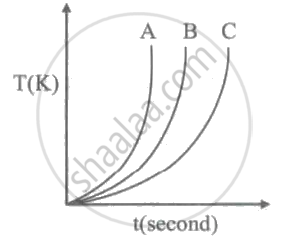Advertisements
Advertisements
Question
The temperature of 170 g of water at 50°C is lowered to 5°C by adding a certain amount of ice to it. Find the mass of ice added.
Given: Specific heat capacity of water = 4200 J kg-1 °C-1 and specific latent heat of ice = 336000 J kg-1.
Solution
Given mass of water = 170 g = 1.17 kg,
Initial temperature = 50°C
Fall in temperature = Δt = (50 - 5) = 45°C = 45K
Heat lost by water = mc Δt
= 0.17 × 4200 × 45
= 3.213 × 104 J
If m' kg ice is added, heat gained by it to melt to 0°C = m'L
= m'C Δt
= m' × 4200 × 5
= m' × 2.1 × 104 J
Total heat gained by ice
= 3.36 × 105 m' + 2.1 × 104 m'
= 3.57 × 105 m' J
By the principle of method of mixtures heat lost by water = heat gained by ice
⇒ 3.213 × 104 = 3.57 × 105 m'
⇒ m' = `(3.213 xx 10^4)/(3.57 xx 10^5)`
⇒ m' = 0.09 kg (90 g)
APPEARS IN
RELATED QUESTIONS
Explain the term boiling ?
Name the radiations for which the green house gases are transparent ?
How much heat energy is released when 5 g of water at 20° C changes to ice at 0° C?
[Specific heat capacity of water = 4.2 J g-1 ° C-1 Specific latent heat of fusion of ice = 336 J g-1]
The specific heat capacity of water is 1 cal/g °C.
Explain how heat capacity of a solid can be determined by the method of mixture.
50 g of copper is heated to increase its temperature by 10° C. If the same quantity of heat is given to 5 g water, the rise in its temperature is [Specific heat of copper = 420 joule-kg-1 °C-1 , specific heat of water = 4200 joule-kg-I °C-1]
Which of the following substances (A, B and C) has the highest specific beat?

Two uniform brass rods A and B of length land 2l and radii 2r and r respectively are heated to the same temperature. The ratio of the increase in the volume ofB to that of A is ____________.
